 Süleymaniye Mosque is the largest mosque in Istanbul and sits on one of the famous seven hills of Istanbul. This picture was taken from our lunch spot.
Süleymaniye Mosque is the largest mosque in Istanbul and sits on one of the famous seven hills of Istanbul. This picture was taken from our lunch spot.
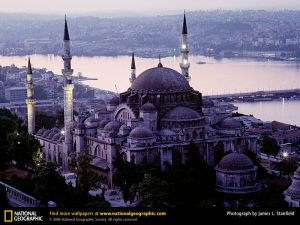 (Photo credit: http://photography.nationalgeographic.com/photography/enlarge/suleymaniye-mosque_pod_image.html) This mosque was built for Süleyman the Magnificent, by the famous architect (mimar in Turkish) Sinan in 1550. It took seven years and more than 3500 men to build it. Mimar Sinan designed the well-known Sultan Ahmed Camii (Blue Mosque), as well as 92 other large mosques, 48 bath houses, 8 bridges, 6 aqueducts, 3 hospitals, and the list goes on. He is well known in Turkey and his architecture is very well respected. When the mosque was finished, Mimar Sinan was the first to open the door to pray. He is now buried at the front of the mosque.
(Photo credit: http://photography.nationalgeographic.com/photography/enlarge/suleymaniye-mosque_pod_image.html) This mosque was built for Süleyman the Magnificent, by the famous architect (mimar in Turkish) Sinan in 1550. It took seven years and more than 3500 men to build it. Mimar Sinan designed the well-known Sultan Ahmed Camii (Blue Mosque), as well as 92 other large mosques, 48 bath houses, 8 bridges, 6 aqueducts, 3 hospitals, and the list goes on. He is well known in Turkey and his architecture is very well respected. When the mosque was finished, Mimar Sinan was the first to open the door to pray. He is now buried at the front of the mosque.
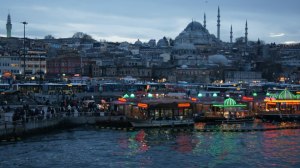 This is a picture of Süleymaniye when I was in Turkey in January. On the far left of the picture you can see a tower. That tower shines green at night and if you’re close by, you can tell which mosque is Süleymaniye because of that tower.
This is a picture of Süleymaniye when I was in Turkey in January. On the far left of the picture you can see a tower. That tower shines green at night and if you’re close by, you can tell which mosque is Süleymaniye because of that tower.
 This pictures shows the two larger minarets (or small towers). There are four on Süleymaniye, with ten balconies, representing Süleyman the Magnificent, the tenth sultan of the Ottoman Empire.
This pictures shows the two larger minarets (or small towers). There are four on Süleymaniye, with ten balconies, representing Süleyman the Magnificent, the tenth sultan of the Ottoman Empire.
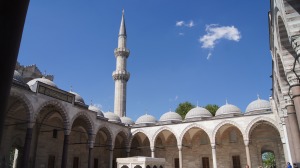 The courtyard was so peaceful and empty when we first arrived.
The courtyard was so peaceful and empty when we first arrived.
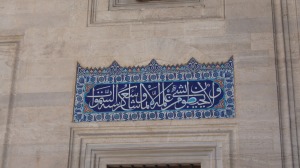 Mosaic tiles with an Arabic saying, found in the courtyard.
Mosaic tiles with an Arabic saying, found in the courtyard.
 The inside dome along the edge of the courtyard, more mosaics.
The inside dome along the edge of the courtyard, more mosaics.
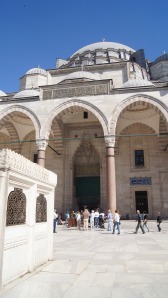 The courtyard entrance. When we first got there, it was pretty empty, but as we were leaving we went to take more pictures of the outside and a huge tour group went in after us. Somehow we avoided the huge crowds right before they got there…well everywhere except for Topkapı Palce (I’ll get into that in another post!).
The courtyard entrance. When we first got there, it was pretty empty, but as we were leaving we went to take more pictures of the outside and a huge tour group went in after us. Somehow we avoided the huge crowds right before they got there…well everywhere except for Topkapı Palce (I’ll get into that in another post!).
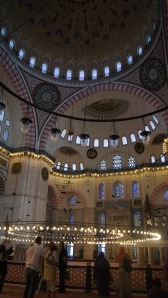 The first view is just breathtaking. It’s so much bigger inside than you would imagine (58x57x53 meters, 190x187x173 feet).
The first view is just breathtaking. It’s so much bigger inside than you would imagine (58x57x53 meters, 190x187x173 feet).
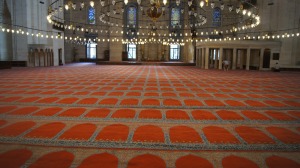 The low hung chandiler makes the huge space seem a little more cozy. And I really enjoyed the choice of carpet. It looks like an aqueduct (which Mimar Sinan did design), but it also looks like separate prayer rugs, neatly placed in lines.
The low hung chandiler makes the huge space seem a little more cozy. And I really enjoyed the choice of carpet. It looks like an aqueduct (which Mimar Sinan did design), but it also looks like separate prayer rugs, neatly placed in lines.
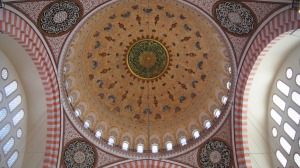 The dome. This picture does it no justice because it is so much more beautiful than this. The dome is a height of 53 meters (173 feet), and the diameter is 26.4 meters (86 feet). When it was built, it was the highest dome in the Ottoman Empire, but still it is smaller than Hagia Sophia (currently standing at 55.6 meters, or 182 feet).
The dome. This picture does it no justice because it is so much more beautiful than this. The dome is a height of 53 meters (173 feet), and the diameter is 26.4 meters (86 feet). When it was built, it was the highest dome in the Ottoman Empire, but still it is smaller than Hagia Sophia (currently standing at 55.6 meters, or 182 feet).
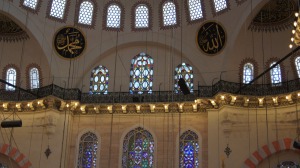 The pillars, as you can see in this picture, line the perimeter of the mosque and support the weight of the dome. Sinan masked the pillars and pushed them into the walls so people could see the openness instead of pillars everywhere. Smaller domes, surrounding the main dome also distribute the weight evenly. The half-domes, or smaller domes, to support some weight of the large dome has a similar style to Hagia Sophia.
The pillars, as you can see in this picture, line the perimeter of the mosque and support the weight of the dome. Sinan masked the pillars and pushed them into the walls so people could see the openness instead of pillars everywhere. Smaller domes, surrounding the main dome also distribute the weight evenly. The half-domes, or smaller domes, to support some weight of the large dome has a similar style to Hagia Sophia.
 Inside you had to take your shoes off, similar to the Blue Mosque. There were many shoe/cubbies near the entrance, and you can get a baggie to put your shoes in. But women also had to wear scarves on their heads. If you don’t have one with you, you can borrow one of their’s, like I did (I’m not sure how sanitary it was though). There were small shops near the mosque that sold various tourist-y things, including scarves, so if you’re a little squeamish, I’d recommend that (plus you can never have too many scarves).
Inside you had to take your shoes off, similar to the Blue Mosque. There were many shoe/cubbies near the entrance, and you can get a baggie to put your shoes in. But women also had to wear scarves on their heads. If you don’t have one with you, you can borrow one of their’s, like I did (I’m not sure how sanitary it was though). There were small shops near the mosque that sold various tourist-y things, including scarves, so if you’re a little squeamish, I’d recommend that (plus you can never have too many scarves).
 There are more than 200 stained glass windows. One of the stories Süleyman told me about Süleymaniye is that it was built with extremely good acoustics. So good, in fact, that the architect was using nargile (similar to hookah in the states), and the bubbles from the container could be heard all over the mosque. Tobacco isn’t allowed in Islam, so when Sultan Süleyman heard, he was so angry he threated to end Sinan’s life for disrespecting the mosque. Sinan calmly responded that nargile has no tobacco and no smoke even, he only used it to hear the bubbles.
There are more than 200 stained glass windows. One of the stories Süleyman told me about Süleymaniye is that it was built with extremely good acoustics. So good, in fact, that the architect was using nargile (similar to hookah in the states), and the bubbles from the container could be heard all over the mosque. Tobacco isn’t allowed in Islam, so when Sultan Süleyman heard, he was so angry he threated to end Sinan’s life for disrespecting the mosque. Sinan calmly responded that nargile has no tobacco and no smoke even, he only used it to hear the bubbles.
 Because this is still a working mosque, and not a museum, during prayer times it was closed off to tourists. But even when tourists are allowed in, some people still use that time to pray.
Because this is still a working mosque, and not a museum, during prayer times it was closed off to tourists. But even when tourists are allowed in, some people still use that time to pray.
 While we gazed at the beauty and took pictures, a small prayer group started. Süleyman told me when there is a group of people praying, one person will become the leader, like an Imam, and guide the other Muslims through a prayer.
While we gazed at the beauty and took pictures, a small prayer group started. Süleyman told me when there is a group of people praying, one person will become the leader, like an Imam, and guide the other Muslims through a prayer.
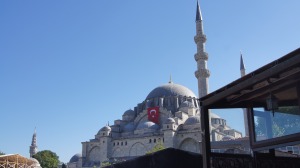 After lunch we went on a walk and found a café with rooftop seating. We drank kahve (Turkish coffee), chocolate for me, pistachio for Süleyman. This was his view.
After lunch we went on a walk and found a café with rooftop seating. We drank kahve (Turkish coffee), chocolate for me, pistachio for Süleyman. This was his view.
 This was my view. I had complained how just by chance he would get the better view, and I wouldn’t notice until we left. But I think we tied this time. I had never seen the Bosporus or Golden Horn so blue.
This was my view. I had complained how just by chance he would get the better view, and I wouldn’t notice until we left. But I think we tied this time. I had never seen the Bosporus or Golden Horn so blue.
 The water directly behind us is the Golden Horn, entering the Bosporus on the right. You can just barely see the Bosporus bridge near the top of the picture. Also, behind Süleyman’s right shoulder, across the river, is Galata Tower, sticking out high above the buildings.
The water directly behind us is the Golden Horn, entering the Bosporus on the right. You can just barely see the Bosporus bridge near the top of the picture. Also, behind Süleyman’s right shoulder, across the river, is Galata Tower, sticking out high above the buildings.
Sources:




































